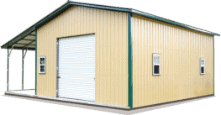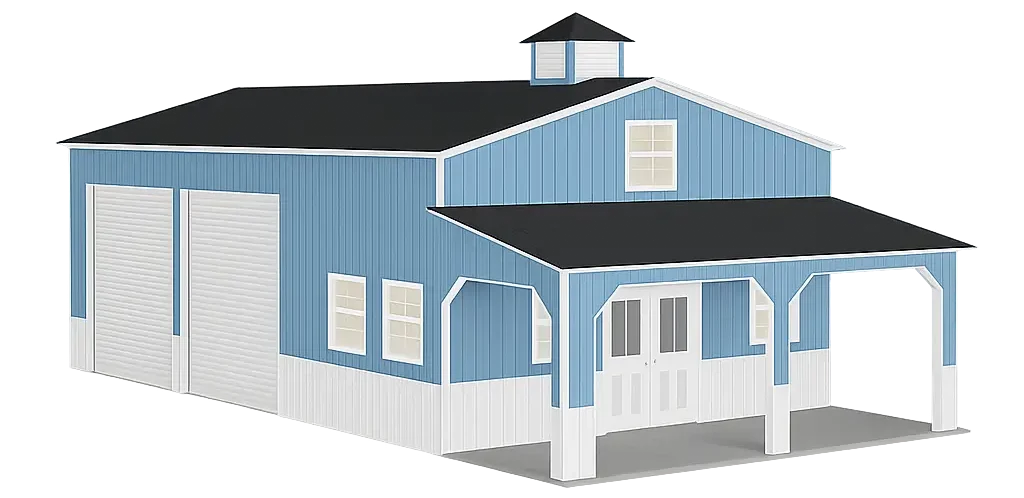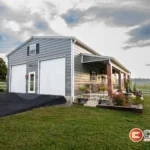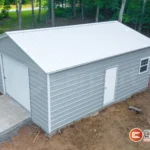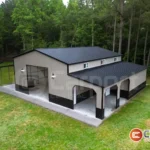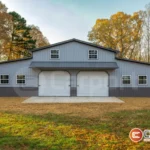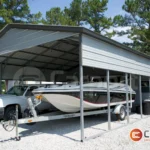16
The Storage Stack: How to Layer Metal Buildings for Maximum Space, Flexibility, and Future Use
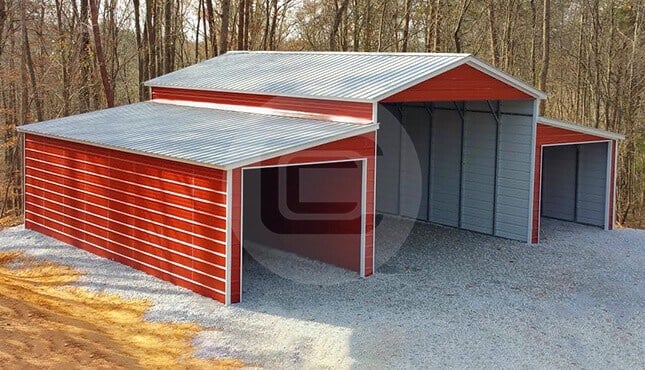
TL;DR
If you’re running out of room for your RV, tools, gear, or equipment, the answer isn’t always a bigger building—it’s a smarter storage setup. This guide explains how to “stack” your space using a layered system of metal barn buildings, camper sheds, carports, and garages. Instead of cramming everything into one oversized structure, we’ll show you how to create a flexible layout that can grow with you, adapt to changing needs, and protect your property better over time.
Introduction: Why Most Storage Setups Fall Short
You get a camper. Then a mower. Then a few tools. And then a side hustle that needs space. Before long, that “plenty of storage” you thought you had feels cramped and chaotic.
This is how most storage plans break down—not because the buildings are bad, but because they’re built for a single need at a single point in time. And needs change fast.
We’ve seen it time and again: someone buys a large garage thinking it’ll cover everything. A year later, they’re squeezing in extra gear, parking under trees, or pricing out another building entirely. The fix isn’t always upsizing. It’s stacking—a smarter way to layer your storage across multiple, purpose-built buildings that work together as a system.
This blog walks you through how to build one.
What Is a Storage Stack (And Why It’s Smarter Than One Big Building)?
A “storage stack” isn’t one huge building. It’s a collection of smaller, smarter buildings—each one designed for a specific job.
Instead of pouring money into one oversized structure that tries to do it all (and rarely does it well), a storage stack separates your space into layers:
-
Covered storage for access and airflow
-
Enclosed sheds for tools, gear, and security
-
Larger barns or garages for vehicles, work, or multi-use zones
This approach has been common in agricultural and homesteading settings for decades. But now, more homeowners, landowners, and small business owners are catching on—because it solves problems that “just build bigger” can’t.
Why a Storage Stack Works Better Than One Oversized Structure
-
More flexibility
You can start small and add over time as your needs grow. -
Better protection
Separate structures let you optimize airflow, security, insulation, and clearance depending on what you’re storing. -
Lower upfront cost
Starting with a carport or shed costs far less than committing to a massive all-in-one build. -
Simpler permitting and placement
Many areas allow smaller buildings to be added more easily than large commercial-sized garages or barns. -
Fewer compromises
You don’t have to sacrifice height for width, or workspace for parking. Each building does its job.
Example:
Instead of building a 40×60 garage to store your RV, car, tools, and gear all in one spot, you could create a smarter layout with:
-
A 30×30 metal garage for vehicles and tools
-
A camper carport with side panels for seasonal RV protection
-
A prefab barn with a lean-to for large equipment or future expansion
This approach usually costs less upfront, gives you more usable space, and sets you up for easier expansion later.
Should You Build All at Once or In Phases?
Should You Build All at Once or In Phases?
One of the biggest advantages of a storage stack is that it doesn’t need to happen all at once. In fact, building in phases can save you money, reduce stress, and give you time to adjust your setup as your needs evolve.
Whether you’re working with a tight budget or just want to see how the first structure fits before adding more, there’s no one right answer—just the strategy that works best for your property.
Benefits of Building in Phases
Lower upfront cost
You don’t have to finance or commit to a massive all-in-one project. You can start with one essential structure (like a camper carport or 30×30 garage), then add as needed.
Fewer regrets
Spacing buildings out over time gives you a chance to evaluate how you actually use the space before locking in the full layout. Many customers realize they’d rather shift a future barn or shed after living with their first setup.
More flexibility with permits and codes
In many locations, smaller individual structures face fewer permitting restrictions or can be added under simpler processes than a single oversized building.
Better alignment with weather and use
You can time your construction phases to match seasonal needs—RV protection in spring, enclosed storage before winter, workspace as your side hustle grows.
Which Structure Should You Start With?
It depends on what’s most vulnerable—or most valuable.
Start with:
-
A camper carport or RV cover if you need sun and weather protection now
-
A camper shed or garage if you need security and enclosed space immediately
-
A metal barn building if you’re running out of space for equipment, feed, or livestock essentials
Then expand based on:
-
Additional vehicles
-
Hobby or business growth
-
Changes in how you use your land or property
Plan Your Layout with Expansion in Mind
Even if you’re building one piece now, think ahead:
-
Leave room for future walkways or lean-tos
-
Align structures so doors and access points don’t conflict
-
Prep utility connections (like conduit) in advance for power or lighting
-
Grade the land with runoff and water flow between structures in mind
Starting with a 20×20 metal carport now? Leave enough pad space beside it for a future camper shed or prefab storage room. Already installing a 30×40 garage? Consider facing it opposite a future metal barn to create a work yard in between.
Bottom line:
You don’t have to build it all at once—but you should build it like you might. A phased storage stack gives you all the long-term benefits of a custom setup without the pressure of doing everything upfront.
What Most People Forget to Include in Their Stack
You can have the right buildings, the right layout, and still run into problems if the little details are off. These oversights don’t just affect convenience—they can shorten the life of your structures, limit their use, or lead to expensive rework down the line.
Here’s what smart builders plan for—and what too many others miss.
1. Ventilation and Airflow
Fully enclosed buildings need to breathe, especially in hot or humid regions. Without airflow, you risk:
-
Mold and mildew buildup
-
Condensation on tools and electronics
-
Overheating in summer months
What to do:
Add ridge vents, gable vents, or exhaust fans to sheds and garages—especially if you plan to store fuel, gear, or anything sensitive to temperature swings.
2. Anchoring and Site Prep Across Multiple Units
It’s easy to think “level the ground, pour a pad, install the carport”—but stacking buildings changes the game. One poorly anchored structure can compromise the alignment and drainage of the others.
What to do:
-
Anchor every building to code
-
Use the same elevation and slope where buildings will connect or face each other
-
Plan ahead for snow melt and rain runoff patterns across the whole area
3. Space Between Buildings
People often place buildings too close together in an effort to save space—but this creates problems for:
-
Walking between buildings with tools or equipment
-
Opening doors and roll-up access points
-
Water pooling in narrow alleys
-
Future expansions or add-ons
What to do:
Leave at least 4–6 feet of clearance between standalone structures—or more if you’re planning to run machinery, ATVs, or trailers between them.
4. Runoff and Drainage Planning
Multiple buildings create new flow paths for rain, snow, and meltwater. If you don’t guide it, water will settle where it wants—usually near your foundation or in a doorway.
What to do:
-
Grade away from each structure individually
-
Install gutters on carports and barns with large roof spans
-
Use gravel or French drains between units when needed
5. Utilities and Future Access
If you’re adding insulation or planning to run electricity later, don’t wait to think about routing.
What to do:
-
Lay electrical conduit underground between building sites before pouring pads
-
Leave room to trench later if needed
-
If lighting or HVAC is part of your future vision, wire and vent your enclosed units accordingly from the start
Pro tip:
Even if you only plan to light one building now, installing a panel with future capacity (or leaving conduit stubs between units) makes it 5x cheaper to expand later.
Bottom line:
Storage is more than square footage—it’s how that square footage functions. Skipping these details doesn’t just create hassle—it shortens the lifespan and usefulness of your entire setup.
When a Custom Metal Building Makes More Sense
Storage stacks offer flexibility, scalability, and lower upfront costs—but they’re not always the best choice for every situation. Sometimes, consolidating your needs into one thoughtfully designed, multi-purpose structure is the smarter move.
If you’re dealing with a tight site, a complex workflow, or simply want to streamline everything under one roof, a custom metal building may deliver more value over time.
When to Consider Consolidating
1. You need climate control across all zones
Heating and cooling three buildings is harder—and more expensive—than managing one well-insulated structure with zoned airflow.
2. Your layout requires frequent indoor movement between areas
If you’re constantly going from workshop to storage to office, walking between buildings (especially in bad weather) adds time and hassle.
3. You’re in a high-regulation area
Some jurisdictions restrict the number or placement of detached structures. A single 40×50 or 30×60 metal building may be easier to permit than multiple smaller ones.
4. You’re short on land
When square footage is limited, you can’t afford 4 feet of buffer between each structure. A custom footprint lets you make every inch count.
5. You’re ready to invest in a long-term, all-in-one asset
One building. One slab. One structure to maintain and insure. If simplicity and longevity matter most, going custom may be the clear winner.
What Custom Metal Buildings Can Include
-
Open bays for parking or equipment
-
Fully enclosed shop space or garage zones
-
Interior partition walls for storage, work, or livestock
-
Climate zones (insulated vs. uninsulated sections)
-
Roll-up doors, walk-in doors, and windows
-
Lean-tos or wraparound porches for shaded access
-
Add-ons like loft storage or integrated drainage
Popular Sizes for Multi-Purpose Custom Buildings
| Size | Best Use Case |
|---|---|
| 30×40 | Garage + storage with room for future lean-to |
| 40×50 | Shop, vehicle storage, plus hobby or work zone |
| 40×60 and up | Full operations hub for homesteads or businesses |
Stack or Consolidate? Ask These Questions
-
Do I want to expand over time or get everything done now?
-
Is my priority access and flexibility, or climate control and simplicity?
-
Would I rather have one foundation and utility connection, or multiple?
-
How much movement will happen between my use zones daily?
-
Is this setup mostly for me—or will I eventually sell or rent this property?
If your answers lean toward centralization, a custom metal building is likely your best investment.
Bottom line:
A smart storage stack gives you options. A well-designed custom metal building gives you control. There’s no one-size-fits-all answer—but Carport Central can help you find the setup that matches your life, land, and long-term goals.
Get Started
It's fast and easy. Get your instant quote today!
BLOG TOPICS
- Certified Carports (2)
- COVID-19 (1)
- Prefab Metal Buildings (66)
- Metal Building Homes (6)
- Metal Building of the Week (11)
- Install of the week (1)
- Metal Building Extensions (1)
- Install of the month (2)
- Garages (52)
- Farm Show (1)
- Building Components (1)
- Carports (29)
- Storage Sheds (15)
- Metal Buildings (6)
- Barns (18)
- Metal Homes (8)
- Metal Sheds (1)
- RV Covers (6)
- 12 Gauge Framing (7)
- Workshops (7)
- Eagles & Buildings (1)
- Reviews (2)
- Snowfall in the Southeast (2)
- Carports and Buildings Prices (1)
- Reality Of Discounted Buildings (2)
- Snow Removal (1)
- Offers (3)
- Condensation in Metal Buildings (2)
- News & Awards (12)
- Livestock sheds (4)
- Installations (15)
- Metal Buildings Applications (7)
- Customized Buildings (41)
- Carport Sizes (2)
- Facts (1)
Metal Buildings
- Alabama
- Arizona
- Arkansas
- California
- Colorado
- Connecticut
- Delaware
- Florida
- Georgia
- Idaho
- Illinois
- Indiana
- Iowa
- Kansas
- Louisiana
- Maine
- Maryland
- Massachusetts
- Michigan
- Minnesota
- Mississippi
- Missouri
- Montana
- Nebraska
- Nevada
- New Hampshire
- New Jersey
- New Mexico
- New York
- North Carolina
- North Dakota
- Ohio
- Oklahoma
- Oregon
- Pennsylvania
- Rhode Island
- South Carolina
- South Dakota
- Tennessee
- Texas
- Utah
- Vermont
- Virginia
- Washington
- West Virginia
- Wisconsin
- Wyoming
Metal Garages
- Alabama
- Arizona
- Arkansas
- California
- Colorado
- Connecticut
- Delaware
- Florida
- Georgia
- Idaho
- Illinois
- Indiana
- Iowa
- Kansas
- Louisiana
- Maine
- Maryland
- Massachusetts
- Michigan
- Minnesota
- Mississippi
- Missouri
- Montana
- Nebraska
- Nevada
- New Hampshire
- New Jersey
- New Mexico
- New York
- North Carolina
- North Dakota
- Ohio
- Oklahoma
- Oregon
- Pennsylvania
- Rhode Island
- South Carolina
- South Dakota
- Tennessee
- Texas
- Utah
- Vermont
- Virginia
- Washington
- West Virginia
- Wisconsin
- Wyoming
Metal Carports
- Alabama
- Arizona
- Arkansas
- California
- Colorado
- Connecticut
- Delaware
- Florida
- Georgia
- Idaho
- Illinois
- Indiana
- Iowa
- Kansas
- Louisiana
- Maine
- Maryland
- Massachusetts
- Michigan
- Minnesota
- Mississippi
- Missouri
- Montana
- Nebraska
- Nevada
- New Hampshire
- New Jersey
- New Mexico
- New York
- North Carolina
- North Dakota
- Ohio
- Oklahoma
- Oregon
- Pennsylvania
- Rhode Island
- South Carolina
- South Dakota
- Tennessee
- Texas
- Utah
- Vermont
- Virginia
- Washington
- West Virginia
- Wisconsin
- Wyoming
- 100x100 Metal Building
- 12x12 Metal Shed
- 12x20 Carport
- 12x24 Carport
- 12x30 Carport
- 16x20 Carport
- 18x20 Carport
- 20x20 Carport
- 20x20 Metal Building
- 20x30 Carport
- 20x30 Metal Building
- 20x40 Carport
- 20x40 Metal Building
- 24x24 Carport
- 24x24 Garage
- 24x30 Carport
- 24x30 Metal Building
- 24x30 Metal Garage
- 24x36 Metal Building
- 26x30 Metal Building
- 30x30 Carport
- 30x30 Garage
- 30x30 Metal Building
- 30x40 Carport
- 30x40 Garage
- 30x40 Metal Building
- 30x40 Storage Building
- 30x50 Metal Building
- 30x60 Metal Building
- 40x100 Metal Building
- 40x40 Metal Building
- 40x60 Metal Building
- 40x80 Metal Building
- 50x100 Metal Building
- 50x50 Metal Building
- 50x80 Metal Building
- 60x100 Metal Building
- 60x120 Steel Building
- 60x60 Metal Building
- 60x80 Metal Building
- 80x100 Metal Building
- All Steel Carports
- American Building Network
- American Custom Carports
- American Steel Carports
- Arkansas Carports
- Best Choice Metal Structures
- California All Steel
- Carports Outlet
- Central Texas Metal Buildings
- Coast To Coast Carports
- Custom Steel Structures
- Dreams Carports and Buildings Inc
- East Coast Carports
- Enterprise Steel Structures
- Infinity Carports
- Interstate Steel Structures
- Long Horn Buildings
- Midwest Steel Carports
- NC Structures
- New Team Carports
- Northside Metal Carports
- Quality Carports
- Rhino Carports
- Safeguard Metal Buildings
- Southern Steel Buildings Inc.
- Steel Buildings and Structures
- Tennessee Steel Buildings
- Tubular Building Systems
- Ultimate Metal Buildings
- United Structures
- USA Carports







